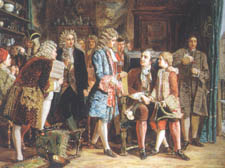|
|
 |
| |
 A Victorian depiction of Alexander Pope as a boy meeting his early Kit-Cat patrons, by Eyre Crowe, detail, (Sotheby’s Picture Library) A Victorian depiction of Alexander Pope as a boy meeting his early Kit-Cat patrons, by Eyre Crowe, detail, (Sotheby’s Picture Library) |
A gathering of friends
who ‘imagined a nation…’
The Kit-Cat Club developed as a unique collection of intellects and interests under William and Mary, Anne and George I – as Illtyd Harrington explains
The Kit-Cat Club:
Friends who Imagined a Nation
by Ophelia Field, Harper Press, £25. Order this book
FORTY-SEVEN Kit kat bars are devoured in Britain every second, and 22 factories around the world pump out millions of this biscuit every day.
The name, I discover, originates from the pie shop of a pastry cook from Norfolk, Christopher Cat, nicknamed Kit.
Around 1695 his tavern, The Cat and Fiddle in Gray’s Inn Lane, became a powerhouse of leading politicians, writers, philosophers and poets who set the political and social agenda for the next 30 years.
Mr Cat’s massive pies and mouth-watering desserts were drowned in “oceans of port, claret, and champagne”. It sounds like a home for heroic drinkers and gluttons who staggered away in the dawn of Friday after their regular Thursday gatherings.
Masterminded by Jacob Tonson, a successful publisher, membership was selective and significant. Between 1714 and 1762, seven members became prime minister, among them Robert Walpole, who is regarded as the first prime minister.
Also members were playwrights William Congreve and Sir John Vanbrugh, who later turned his hand to architecture, building Blenheim Palace and Castle Howard, where the 1981 Brideshead Revisited TV drama was filmed.
They were Whigs. Aristocratic major land owners were the main influence; they were anti-catholic but also the source of qualified religious toleration. They were quite strong in their attitudes to censorship, rare in those days.
Queen Anne feared their growing influence and often favoured their opponents, the Tories. Some of the club were instrumental in ending the enervating war of the Spanish Succession.
They sponsored the Act of Union with Scotland in 1707.
Lord Thomas Wharton became the Lord Lieutenant of Ireland and took with him club member Joseph Addison as his number two.
Wharton feathered his nest but they tamed a great deal of religious bigotry in Ireland. Richard Steele and Addison held government sinecures but are regarded today as the fathers of British journalism. Their paper, The Spectator, was read by 40,000 people.
Vanbrugh built the Haymarket Theatre.
It had 900 seats. They coaxed Frederick Handel to London and tried to introduce Italian opera.
They were blatant nepotists, experts in “cronyism”, ruthless at intrigue, brimming with self-assurance.
Their liberality was challenged by nine branches of the Society of the Reform of Manners in London.
The Kit-Catters were roundly accused in the Lords and Commons as the authors of lewd behaviour and moral decadence.
In the main, they were financially adroit.
In April 1709 many of them guaranteed the national debt through the Bank of England. Kit-Cat governors were among the biggest depositors, although later some of them burnt their fingers in the South Sea Bubble, when it financially collapsed, except Robert Walpole who saw the crash coming.
He became their political godfather and arch manipulator.
The arrival of George I from Hanover altered the political landscape because it brought about acute polarisation: you were either for the King or the Prince of Wales. Gradually, their far-reaching influence wained owing to death, declining significance in metropolitan life, alternative forums, and new faces and ideas, and a more resilient grouping of Tories.
The club in its time was very powerful, mainly through its personal solidarity and intellectual antennae.
As Ophelia Field writes: “The Kit-Cats not only made it look easy to reform a nation constitutionally, but also to reform the fundamental attitudes and aspirations of the nation.”
After her superb life of Sarah, Duchess of Marlborough, Field has unearthed a rich vein of misplaced history in 1690-1730, blending atmosphere with accuracy and, above all, readability.
When you walk up Haverstock Hill past the Richard Steele, remember he was a Kit-Catter, who had a cottage virtually on the site. |
 |
|
 |
 |
|
 |
|
 A Victorian depiction of Alexander Pope as a boy meeting his early Kit-Cat patrons, by Eyre Crowe, detail, (Sotheby’s Picture Library)
A Victorian depiction of Alexander Pope as a boy meeting his early Kit-Cat patrons, by Eyre Crowe, detail, (Sotheby’s Picture Library) 

